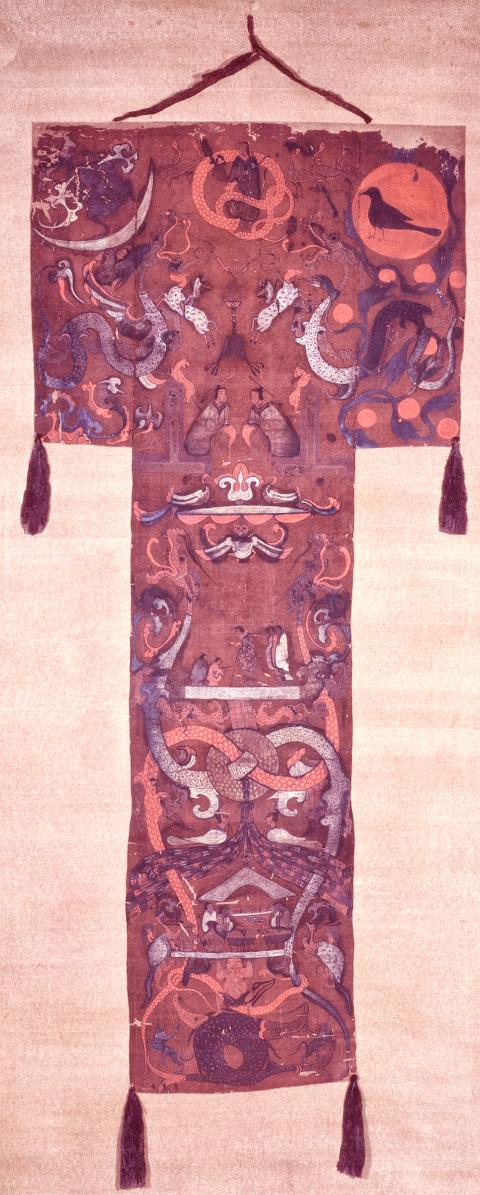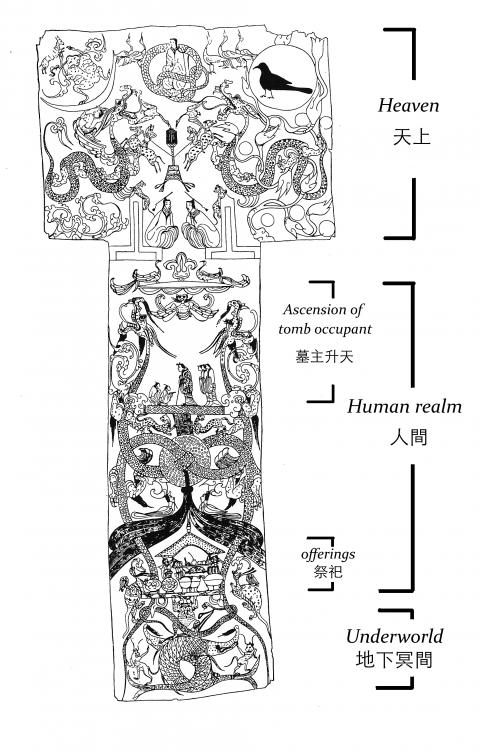The three Han Dynasty tombs excavated in 1972 at Mawangdui in Hunan’s Changsha was an extremely significant archaeological discovery. Tomb no. 1, in particular, found in a state of complete preservation, contained not only the perfectly mummified corpse of the tomb occupant Lady Dai — personal name Xin Zhui — but also a wealth of cultural artifacts. Among these, the most spectacular was an exquisite T-shaped silk banner.
The banner painting, on purplish-red dyed silk, was divided into three sections, depicting Heaven, the human realm and the Underworld. The horizontal top section represents Heaven, with a sun on the top right corner containing the Golden Crow and a moon to the top left with a toad. Between these sits a creature with a human head upon a serpent’s torso: the mythological creator of humans Nuwa (or Fuxi). At the base of this section sit two deities — thought to be a senior and junior judge of life — lying sentry to the entrance of Heaven.
The vertical section of the painting below this shows a noblewoman (Lady Dai) standing, with the aid of a cane, in the middle of a platform, accompanied by servants in front and behind her, as if preparing her for her ascension to Heaven.

Photo: Wikimedia Commons
照片:維基共享資源
A pair of dragons, intertwined through a ritual jade bi disc, serve as a divider between the platform above and a scene below of the woman’s descendants making offerings of delicacies. This scene is being supported from below by the mythical creature Gun, who is himself standing upon a pair of whales with interlocking tails.
The T-shaped banner was to be used in the “calling of the soul” ritual following a death. It would have been hung at the front of the funeral procession to guide the soul into the burial chamber, and from there on its journey to Heaven. Above and beyond this function, the banner is testament to the exquisite artistry of the time, and tells us much about the folk religion and world view of the period.
The painting as a whole uses heavenly bodies together with the symbols and iconography of the creation of the universe and mythological creatures to represent the cosmological order; its vertical composition not only portrays the structure of the world view, it also encapsulates a chronological narrative, reading almost like a comic strip.

Photo: Paul Cooper, Taipei Times
照片:台北時報古德謙
At the same time, the individual scenes are filled with profound decorative and symbolic meaning, with the jade bi discs, musical instruments such as the zhong bells and qing chime stones and the flowing lines of the four dragons — two in Heaven and another two interlocking dragons extending up from the Underworld into the human realm — hold the entire composition together. The banner is a perfect example of the linear beauty of traditional Chinese visual art.
(Translated by Paul Cooper)
一九七二年於湖南長沙馬王堆出土的三座漢墓,是極重要的考古發現,尤其是保存完整的一號墓,不但有墓主軑侯夫人辛追未腐化的身軀,還有豐富的文物藝品。其中最引人注目的,是一件精美的T形帛畫。
這幅在染成絳色絲絹上的彩繪,分成天上、人間、地底三個部分。置頂橫向畫面描繪的是天上:有右上方的太陽(金烏)、左上的月亮(蟾蜍),及中間人首蛇身的女媧(或伏羲);底下則有看守天界入口的兩位神祇(一般認為是大司命與少司命)。
以下垂直部分的畫幅,是一位貴婦(即軑侯夫人)拄杖站在一平台中央,前後有隨從服侍,似正準備升天。
在這之下以龍和玉璧交穿的圖樣做出分隔,再往下是子孫奉上山珍海味的祭祀場景。這祭祀場景,是由地底下的神話人物鯀所撐起,鯀腳底下踩著兩尾互相交錯的鯨鯢。
這T形幡是用來招魂的特定形式,出殯時懸掛在前,引導亡靈至墓中,然後升天。這件帛畫更讓我們一窺當時精美的工藝,以及民間的信仰與世界觀。
它整個畫面以日月星辰、創世神話人物、神獸等符號圖騰布局,鋪陳出宇宙的秩序;其上下分層及位置安排,不僅是世界觀的構築,也是時間上的敘事,如同連環漫畫的分鏡。
然而其「分鏡」,本身即深具裝飾性與圖騰意義,例如玉璧,和鐘、磬等樂器的運用,以及用四條龍(天上兩條,及貫穿人間與地底的兩條交纏的龍)的靈動線條,來羅織貫穿整個畫面構圖。咸認中國傳統視覺藝術是「線條」的藝術,由此可見。
(台北時報林俐凱)

A: While Taylor Swift’s new album conquers the Billboard charts, Billboard Live Taipei is set to open next month. B: Isn’t that a Japanese “live house” of the same name with the magazine? A: Yup, and the live music club’s first Taiwanese branch can accommodate 300 guests. B: Who will be performing at the club’s opening show? A: Japanese singer Mika Nakashima will play four gigs over two nights. Wanna go to the club and watch her perform up-close? A: 天后泰勒絲的新專輯再度征服《告示牌》排行榜,告示牌音樂台北則預計將在下月開幕。 B: 那不是跟《告示牌》同名的日本現場音樂餐廳嗎? A: 對,這家連鎖餐廳的台灣首店約可容納300名觀眾! B: 開幕秀的表演者是誰? A: 是日本歌手中島美嘉,想近距離看她現場演出嗎? (By Eddy Chang,

In his famous tragic play Romeo and Juliet, the English playwright William Shakespeare wrote, “What’s in a name?” As it turns out, there is quite a lot in a name, particularly a surname, which is commonly known as a person’s last name in Western societies. A surname is written after the first name, which is also referred to as a given name or, traditionally, a Christian name. A closer look at the history of surnames reveals some fascinating insights into their origins. It may come as a surprise to some that up until about 1,000 years ago, surnames were

A: US singer Taylor Swift finally released her 12th album, titled “The Life of a Showgirl,” on Oct. 3. B: The pop diva’s dominating the Billboard charts once again. A: Earlier this year, she also successfully bought back the master recordings to her first six albums. B: And the good news keeps coming, as she and NFL superstar Travis Kelce announced their engagement not long ago. A: Wow! It must be her lucky year. A: 美國歌手泰勒絲10月3日終於推出第12張專輯︰《The Life of a Showgirl》。 B: 流行天后又再次稱霸《告示牌》排行榜。 A: 今年稍早時,她還成功買回了她自己前6張專輯的錄音母帶。 B: 而喜事連連,她和美式足球巨星凱爾西近日宣布他們訂婚了。 A: 哇今年真是她的幸運年! (By Eddy Chang, Taipei Times/台北時報張迪)

Continued from yesterday(延續自昨日) https://www.taipeitimes.com/News/lang While many early surnames in England were strongly influenced by the work people did, like Carpenter or Plumber, jobs were not the only factor. Physical characteristics, personal nicknames, geographical locations and even parents’ first names also played a role. It’s not hard to imagine how the color of a person’s hair could have led to a surname like “Redhead” or “White,” while a darker complexion might have resulted in the last name “Black.” Meanwhile, someone known as a quick runner might have earned the surname “Swift,” while a clever or cunning individual could have been called “Fox”